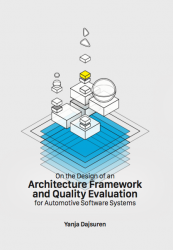On the Design of an Architecture Framework and Quality Evaluation for Automotive Software Systems
Yanjindulam Dajsuren
promotor: prof.dr. M.G.J. van den Brand (TU/e)
copromotor: dr. A. Serebrenik (TU/e)
Technische Universiteit Eindhoven
Date: 26 May, 2015, 14:00
Summary
Nowadays, 90 percent of the innovation in vehicles is enabled by software. Over the past thirty years different methods have been developed to tackle the increasing complexity and to decrease the development costs of the automotive software systems. In the scope of this thesis, automotive architectural modeling and quality evaluation methods have been addressed. According to the ISO 42010 standard, an Architecture Description language (ADL) and an Architecture Framework (AF) are the key mechanisms used in architecture descriptions. ADLs can exist without respective AFs. However, the successful application of an ADL can depend on the proper definition of an AF, since an AF enables better organization and application of an ADL with clear separation of concerns. Although automotive ADLs have been developed over the last decade, only in recent years, automotive companies started to take initiative in defining an architecture framework for automotive systems, e.g., the Architecture Design Framework by Renault. The first draft of the Automotive Architecture Framework (AAF) was already proposed half a decade ago by Broy. The first contribution of this thesis is the definition of an Architecture Framework for Automotive Systems (AFAS), which fills a major gap between existing automotive AFs and ADLs that was identified during the literature review and the evaluation of automotive ADLs.
During the evaluation of automotive ADLs, we identified the lack of the capability to ensure the architectural quality. Even though quality models based on the ISO/IEC SQuaRe quality standard have been specified for MATLAB Simulink design models, the quality framework for automotive architectural models has not been defined. Based on a series of structured interviews with architects (from one automotive company) responsible for modeling automotive software at different architectural viewpoints, we identified consistency, modularity, and complexity as the three main pillars of quality for automotive architectures. Modeling hierarchal elements consistently from different architectural viewpoints, and handling data and control complexity are the key needs of automotive architecture modeling. Therefore, the second contribution of this thesis is the definition and development of the quality evaluation framework for automotive software systems.
Ensuring consistency between the different architectural viewpoints is one of the key issues regarding architectural quality of automotive systems. Correspondence rules between architectural viewpoints are not formally defined in the scope of the automotive architecture description mechanisms. Therefore, we propose a consistency detection mechanism based on correspondence rules between automotive architectural viewpoints and developed a prototype tool to perform this consistency checking between different architectural viewpoints. The consistency checking approach and the prototype tool were evaluated in the scope of an Adaptive Cruise Control modeling between two separate teams emulating OEM and automotive supplier.
To evaluate modularity and complexity, we follow the Goal-Question-Metric (GQM) approach. By conducting a series of interviews with automotive architects and reviewing relevant standards, we have identified complexity and modularity aspects serving as goals in GQM. Then based on the academic and industrial publications, we have identified a series of questions that need to be answered to achieve the aforementioned goals. Automotive architects have again reviewed these questions. Finally, we have defined metrics required to answer the questions, and identified/implemented tools capable of measuring and presenting these metrics. The quality framework has been applied to industrial automotive architectural and design models. Results of the framework application have been evaluated by means of qualitative and quantitative analyses. By applying the framework to three subsequent releases of an architectural model and the corresponding design models, we have observed, for example, that addition of new functionality or bug fixing in design models often come at a price of increased complexity at the design level, and sometimes compromise modularity of the architectural model.
To facilitate the quality evaluation process, the framework applies visual analytics approach for the visualization of modularity and complexity with the help of SQuAVisiT toolset. This approach enables early feedback about software quality making it cheaper and easier to reuse and maintain than traditional techniques. In addition to the visualizations, a mechanism for clone management based on Variant Configuration Language (VCL) is developed to manage model clones and variants. The benefits of using VCL as the variability technique includes separating the variability concern from the functionality concern. The variability mechanism has been validated by converting a number of clone pairs with a varied set of differences into generic representations of VCL.
To summarize, we defined an architecture framework for automotive software systems with a coherent set of viewpoints and views for automotive ADLs. Having a coherent set of architecture viewpoints and views and analyzing automotive specific needs for architecture description mechanisms, we identified consistency, modularity, and complexity as the three main quality attributes for automotive software systems. We developed a correspondence rule based method for ensuring consistency between different architectural viewpoints and defined metric sets for assessing modularity and complexity as part of the quality framework. The quality framework is also extended by the quality visualization and clone detection mechanisms to improve software quality.